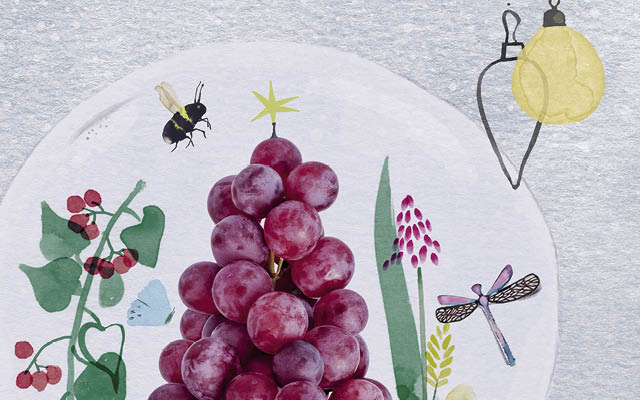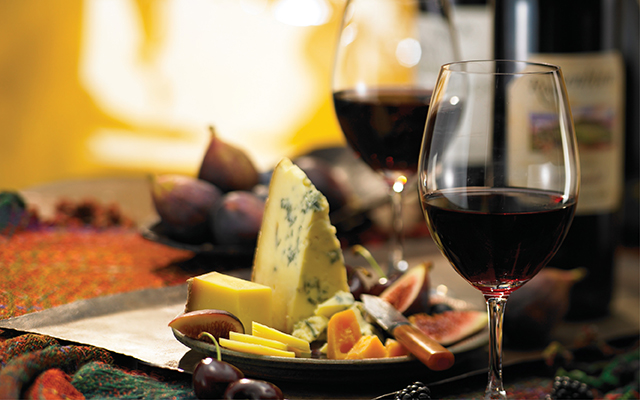Have you ever seen a corner of nothing that changed your whole outlook? This happened to me while I was exploring a renowned vineyard in Sauternes, France, with a group of wine writers.
The corner of nothing was 40 feet from a row of grapevines, near a stone wall in Château Guiraud, one of the world’s finest producers of Sauternes, a delicate, sweet white wine from Bordeaux that to me is one of life’s most supremely captivating treats (especially when paired with blue cheese).
This particular corner was nothing special — just a grayish stack of rocks dappled with colorful lichen and moss. At the base of the stack, emerald-green grasses and flowers as tiny as jewels and as big as dinner plates bloomed.
Meanwhile, a buzzing carnival of life flitted by. Bunnies, beetles, bustling brown birds, and bashful zinging-by things I couldn’t quite see caught my attention.
It was a common scene, a forgettable scene, and I would have forgotten it if not for one thing: When I lifted my eyes to the vineyard beyond the stone wall and a buffer zone, I saw death.
No emerald-green grasses and no jewel-flowers. No birds or bunnies. Just brownish-gray soil, cracked and crumbling and dusty, threaded with narrow black irrigation tubes. Over there, grapevines grew straight from the dust, like plastic flowers desperately stuck into sand after the apocalypse.
Our guide saw what I was viewing, lowered his head and then his voice. Until 1996, he told me, Château Guiraud had also been employing the same fertilizers, pesticides, and herbicides as the neighboring vineyard. Use of this petrochemical cocktail transformed winemaking after World War II.
In the 1990s, however, different owners, winemakers, and growers associated with Guiraud all began to notice what they perceived to be a reduction in the wine’s quality and vitality throughout their region, even if no one else tasted it yet. They began to worry that the farmers on their particular region of spectacular farmland had, through good intentions, destroyed the most valuable thing they owned: their land.
But they had miracles on their side — namely, nature. They were able to, with all the ordinary things farmers have known how to do for thousands of years, bring their vineyard back. They rebuilt the soil with plants and manure, and in 2011 Château Guiraud earned organic certification.
A few years later, they conducted an insect census on their property and found 635 varieties, more than triple that of a conventional Bordeaux vineyard. While it may not seem preferable to have so many insects inhabiting a vineyard, it turns out that a diverse and healthy ecosystem contains a variety of predators that eat problem insects. More bugs meant that pesticide use had declined.
The guide told me all of this in a lowered voice, because he could taste the diminished quality of the wines from that dusty vineyard across the way, and these were neighbors who were stubborn. It was a difficult subject.
The Rise of Natural Wines
But not all of his neighbors were dug in. As I write this, one of those nearby wineries, the renowned Château d’Yquem, is going biodynamic, practicing an ethically rooted method of farming that follows organic principles and adds a few more steps.
Did Yquem winemakers also stand at that corner of nothing where I stood to see life underfoot and death next door? Bordeaux is not that big; I imagine word gets around.
Or maybe they’re just following industry trends. The big development over the past decade has been the rise of natural wines. These are made from grapes grown organically or biodynamically. The vineyards may or may not be irrigated, but they often aren’t. (The European Union has banned irrigation in the past, though some countries have relaxed those restrictions. Plenty of American wineries — Honig and Frog’s Leap come to mind — create great wine without too much watering.)
Although there are currently no industry-accepted standards for natural wine, it is made in the cellars without most of the dozens of additives industrial winemaking uses.
In the 10 years since my book, Drink This: Wine Made Simple, came out, the natural-wine movement has grown from something wine critics joked about to a not-quite-mainstream phenomenon. The website Grub Street recently counted 27 bistros and wine shops in New York City alone that specialize in natural wine.
By my own back-of-the-envelope calculation, there are probably a few hundred such spots in the country, including the Chicago wine bar and shop Red & White, the Antler Room in Kansas City, the Punchdown in Oakland, Bar Brava in Minneapolis, and 13 Celsius and Public Services in Houston. Just about every city seems to have a wine shop with a natural section.
But Is Natural Really Better?
This is the part of the story where I feel a certain pressure to state that natural wines taste better than conventional wines. This is sometimes true — organic, dry-farmed Château Guiraud and Château d’Yquem are some of the finest wines on God’s hopefully forever-green Earth.
Plenty of other natural wines are spectacular; I’m partial to the subtle and complex flavors of natural bubbly wines called pét-nat, short for péttilant-naturel, which produce their own bubbles without winemakers fussing with the wine after fermentation begins.
Yet natural wines are not always better than their conventional competitors. I’ve tasted some sour and funky white wines that could have used a little more intervention.
At this point in my life, however, I prefer natural wines; I’d rather spend time with something authentic and flawed than something fake and boring. But that might just be me.
I also can’t yet tell you to drink natural wine for its health benefits. No studies have compared the health of conventional-wine drinkers with those who choose natural varieties. There is even some research suggesting that wines made from organically grown grapes may contain traces of glyphosate, a probable carcinogen. It’s much less than you’ll find in conventional brands, but still. . . .
I will say that when I consult my own common sense, it tells me that limiting my exposure to herbicides and pesticides is good for the microflora that live in my gastrointestinal tract, and when my microbiome is happy, I’m happy. But that’s just my own gut feeling.
What I can state definitively is that I have seen what is being done in vineyards. I have seen vibrant, peeping, and whirring life, and I have seen gray, dusty death. I’m no doctor, but I often use the profession’s motto: “First, do no harm.” Why should I do harm to the earth when I’m lifting a glass at the holidays? Why should I harm creatures I can’t see when I’m bringing you a hostess present?
I’ll never forget that little corner of nothing near that stone wall in France — a gift from the world to me so I could see how the organic clockwork of nature works. It’s a gift I use whenever I pick bottled gifts for my friends, or raise a vital glass.




This Post Has 0 Comments